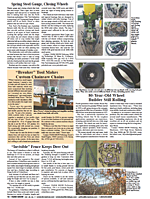You have reached your limit of 3 free stories. A story preview is shown instead.
To view more stories
To view more stories
SUBSCRIBE OR RENEW NOW
(If your subscription is current, click here to Login or Register.)2025 - Volume #49, Issue #5, Page #26
[ Sample Stories From This Issue | List of All Stories In This Issue]
Kit Preserves In-Ground Posts
Ken McDonnell has been making in-ground posts last longer for 28 years. He credits a customer for inspiring him to start. McDonnell had just transitioned from home construction sales to pole barns.“A customer asked me how long the in-ground posts would last,” says McDonnell. “I didn’t know, so I started looking..........

You must sign in, subscribe or renew to see the page.

You must sign in, subscribe or renew to see the flip-book
Kit Preserves In-Ground Posts
Ken McDonnell has been making in-ground posts last longer for 28 years. He credits a customer for inspiring him to start. McDonnell had just transitioned from home construction sales to pole barns.
“A customer asked me how long the in-ground posts would last,” says McDonnell. “I didn’t know, so I started looking for people who did.”
He didn’t settle for what the post vendors told him. Instead, he consulted researchers at the Drexel University Geosynthetics Institute and the Mississippi State University College of Forest Resources.
The people at Drexel explained how different soil types, moisture, concrete and, in livestock applications, animal waste impact posts after contact. McDonnell learned that it’s soil organisms feeding on the wood, not moisture, that causes decay.
He also learned about the chemical preservatives that were used.
“They prescribed the material that is our Post Protector,” says McDonnell. “It’s a product barrier, a physical barrier against wood-destroying organisms.”
McDonnell says MSU Forest Resources were at the forefront of decay protection.
“They educated me on how decay occurs and how to stop and prevent it,” he adds.
McDonnell developed his post wall protector and skirt-board. It’s made from the same material used in landfill liners and claims a 449-year lifespan for geo applications.
“You don’t want soil contact or exposure to the environment,” says McDonnell. “The wood-destroying organisms are in the atmosphere, too. That’s why posts sticking out of concrete will fail at grade level. That’s where the moisture is.”
McDonnel explains that decay needs oxygen, moisture and organisms.
“At grade is where the moisture is and where the organisms attack,” he says. “Decay happens from at grade level to 18 in. in the ground because that’s where the oxygen is. The deeper you go, you starve the organisms of oxygen.”
While the Post Protector is designed for 4-ft. embedments, if the hole is deeper, he recommends cutting away the bottom of the Post Protector and sliding it up the post to ensure the top edge is about 4 in. above the finished floor grade.
The goal of the Post Protector is to create a barrier that prevents organisms from entering, spanning from the bottom of the post hole to the finished floor grade. It can be backfilled with soil, concrete or stone. Horizontal perimeter ribs on the protector, along with the provided hardware, also offer uplift protection. Holes drilled in the fabric help eliminate moisture.
Chemical preservatives in treated posts are pesticides. They’re toxic to wood-decaying organisms. Over time, they leach out and lose their effectiveness. McDonnell explains that the Post Protector helps keep the chemicals in the posts.
For existing in-ground posts installed without a Post Protector, McDonnell offers a preservative life extender. He got the idea when watching a crew dig around a utility pole. When he asked them what they were doing, they explained that they re-treat utility poles every six to 10 years to replenish the pesticide levels in the posts.
The manufacturer of the product had been distributing it to the utility industry for 30 years, but never to the retail market. McDonnell negotiated the rights to that market and launched Post ProServative.
“It’s a simple way to renew the chemical barrier to the wood-decaying organisms,” says McDonnell. “It’s a solid, copper-boron stick. Simply drill a 4-in. deep hole into the post at a 45-degree angle at ground level and slide in the stick.”
He explains that when the post reaches 25% moisture, the copper-boron dissolves and the liquid disperses throughout the wood fibers wherever a void exists. The more moisture there is, the farther the solution can reach.
“About every 10 years, you simply drill out the old stick and insert a new one,” says McDonnel.
Post Protector is available in various sizes and shapes for residential, post-frame and grade guard applications. A skirt-board protector can also be purchased. Prices differ based on post size and the level of protection needed.
Post Protector and Post ProServative are available online from Tractor Supply, Lowe’s and Home Depot. A 6 by 6 by 42-in. Post Protector costs $35.99 at Tractor Supply. A 24-piece kit of Post ProServative sticks and caps is $80.99 at Tractor Supply.
Contact: FARM SHOW Followup, Post Protector, P.O. Box 187, Pottsville, Penn. 17901 (ph 570-624-7030 or 877-966-8768; sales@postprotector.com; www.postprotector.com).
To read the rest of this story, download this issue below or click here to register with your account number.



